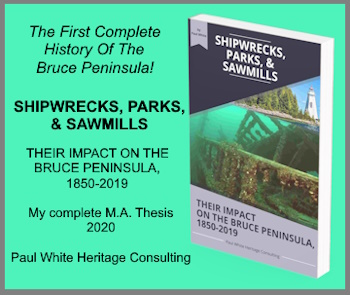Shipwrecks: The Asia
Shipwrecks: The Asia wrecked off Georgian Bay's eastern coast taking all but two of the more than 100 passengers to a watery grave.
As winter approaches it seems that shipping traffic increases on the Great Lakes. The threat of the impending ice and snow from the coming winter spurs everyone to action. This rush to transport goods before the winter freeze-up has always occurred on the Great Lakes. Unfortunately, this is also a time when the lakes are very unpredictable. Consequently, there have been many sailing disasters during the fall shipping season. One of the worst shipwrecks occurred in mid-September 1882.
On September 13, 1882 the wooden propeller the Asia arrived in Owen Sound. After unloading cargo and taking on more goods and passengers the vessel left port around 1:00 am on September 14. She was carrying equipment, horses and provisions for the camps on the north shore. As well, the Asia had a larger than usual number of passengers. There does seem to have been an accurate listing of the actual number of people who had boarded the vessel. Although it is thought that more than one hundred were aboard.
To make matters worse the Asia had not been properly loaded. Although the holds contained cargo, the crew had to put some of the load on the deck, including the hurricane deck. It was thought that this had been done to facilitate easier loading and unloading. There were more passengers than the staterooms could accommodate. Thus, many people slept on the deck or on rugs in other rooms.
Such conditions certainly made the Asia susceptible to becoming a shipwreck disaster. Built as a canaller her 136-foot length allowed her to easily pass through the 140-foot locks on the Welland Canal. The Asia was designed to carry as much as possible. She appeared to be top-heavy, but if her holds were full the vessel seemed capable of withstanding heavy seas.
After leaving Owen Sound the Asia headed into Georgian Bay. The first stop was to be French River village which was a centre for the lumbering industry on the north shore. A heavy south east gale was howling. When Captain Savage ordered her turned toward their first port of call the winds struck the Asia broadside.
What exactly happened next, no one will ever know for sure.
James Barry’s Georgian Bay: The Sixth Great Lake provides us with an eye witness account of one of the two survivors. However, Dunk Tinkiss only recalled what happened as the ship was rolling.
...my uncle was awakened by the rolling of the ship and springing out shouted to me, “Dunk, jump up, the boat is doomed!” The expression on his face was alone sufficient to convince me that it was only too true, and throwing on my coat we both rushed on deck. The sight that met my eyes was a fearful one and one that I shall never forget. The storm was raging, the wind was blowing a perfect hurricane and the waves appeared to rolling mountains high. This was not all for nearly all the passengers by this time had come on deck and scene which followed was a most heart-rending one and entirely beyond description. Until my dying day I shall never forget the cries and shrieks, a majority being on their knees, crying for mercy and deliverance, and all realizing that they were face to face with death.
In fact, with the exception of Tinkiss and another teenager, Christine Morrison, all aboard the Asia perished. Sadly, the shipwreck of the Asia remains one of Georgian Bay's best kept secrets.
Shipwrecks: The Sinking of the Asia first appeared in my weekly column in the Owen Sound Sun Times.
Georgian Bay Shipping
List of Lighthouses on the Great Lakes: If you have names and/or pictures of Great Lakes Lighthouses please submit them along with details of their location.
Georgian Bay Ships: A List of all the ships that sailed on Georgian Bay until the 1960s. This list is not complete. If you know of a ship that sailed the waters of Georgian Bay please contact me with information about that vessel, and, if you have a picture that I could post with it, that would be much appreciated.
1885: A Memorable Summer Job for Owen Sound teenage boys on the Great Lakes would have historic importance, not mention a possible exciting career opportunity.
Hindman Transportation Company was a well-known Great Lakes shipping company for many years. Here you will find pictures of many of the Hindman ships
Owen Sound Harbour – A Photographic History, by Robert A. Cotton is a book that interests my historiographical curiosity.
Commercial Great Lakes Fishing It is probably safe to suggest that the commercial fishing industry was an important part of the early growth of this region.
A Georgian Bay fishing vacation has long been a popular attraction in the Bruce Peninsula region. During fishing derbies, the regional waterways are dotted with fishing boats of all shapes and sizes.
The Georgian Bay Mackinaw, designed by William Watts of Collingwood is an example of a Georgian Bay innovator creating a vessel to service the needs local mariners.
Great Lakes fishing is an asset that is protected and developed, not only for its economic potential but also for those who just enjoy spending a day by the side of a river or in small fishing boats trying to catch “the big one”!
Great Lakes Fishing History is not without its controversy. The impact of the fishing industry was such that it played an important role in the development of communities along the Georgian Bay and Lake Huron shoreline.
Georgian Bay Travel Before the Winter Freeze-Up could be a dangerous time for mariners in the early years in this region.
A Harbinger of Spring on the Great Lakes in pioneer times, was the eagerly awaited news that a lighthouse had been lit and shipping traffic could begin sailing from port to port.
Lumber Hookers Lumber hookers and tugs were an important innovation to improve the transportation of lumber on Georgian Bay.
Mapmakers on Georgian Bay were also explorers. They mapped the Georgina Bay shoreline noting safe harbours, dangerous reefs and other guides for sailors and pioneer settlers looking for a place to call home.
Paddling Georgian Bay & Pondering: traversing parts of this great waterway in a canoe leads one to wonder about the ships of a bygone era battling the rough seas they encountered.
Parry Sound Shipping History: The Parry Sound area has always been connected to the southern regions of the Province of Ontario by a system of good roads. Or has it?
Parry Sound’s shipping history 2 is more than the tragic sinking of the Waubuno or the later catastrophe surrounding the sinking of the Asia.
Sailing Season Closing: A Frantic Time on Peninsula as ships raced from port to port delivering and picking up passengers and produce before the waterways froze.
Ship Captain Andrew Port was not only a dynamic and brave Georgian Bay mariner, he was a personal favourite historical character of mine.
Ships Stuck in Ice: The Oak Glen was icebound in 1996 but this sailing hazard has been impacting vessels on Georgian Bay since the beginning of time.
Lake Huron shipwrecks, the Hibou often occurred in the Georgian Bay region of that Great Lake due to the often violent waters that could strike unsuspecting vessels like the Hibou.
Shipwrecks: The "Asia" wrecked off the eastern coast of Georgian Bay taking all but two of the more than 100 passengers to a watery grave.
Masters, Mates, and Pilots Association created its first Canadian chapter on Georgian Bay, providing maritime safety education, and other seafaring issues to better inform its membership.
Pioneer Travel Aboard the Fly Tells the story of a sailing vessel as the tenuous link between survival and death in a pioneer settlement in the 1840's in Upper Canada.
Sailing Stories: the Captain Who Smelled his way into Port The Captain Who Smelled his Way into Port details how pioneer seamen on Georgian Bay safely sailed the rough waters without the aid of the modern technological tools so readily used by today's mariners.
Sailing Story: The Voyage of the Prince Alfred the incredible voyage of the Prince Alfred, fraught with danger for both vessel and the crew in the winter of 1880.
Shipbuilding As the southern Georgian Bay region became more populated shipping traffic increased to meet the needs of an expanding market place.
The Summer of 1844 was No Picnic for the early settlers in the pioneer area near what would become Owen Sound on Georgian Bay.
The CPR Grain Elevator Fire of 1911 spelled the end of Owen Sound's role as the eastern terminus of the CPR Great Lakes Fleet.
Georgian Bay shipping occurred long before the first Europeans paddled these waters. But the fur and timber trades opened Georgian Bay to shipping in a big way!





